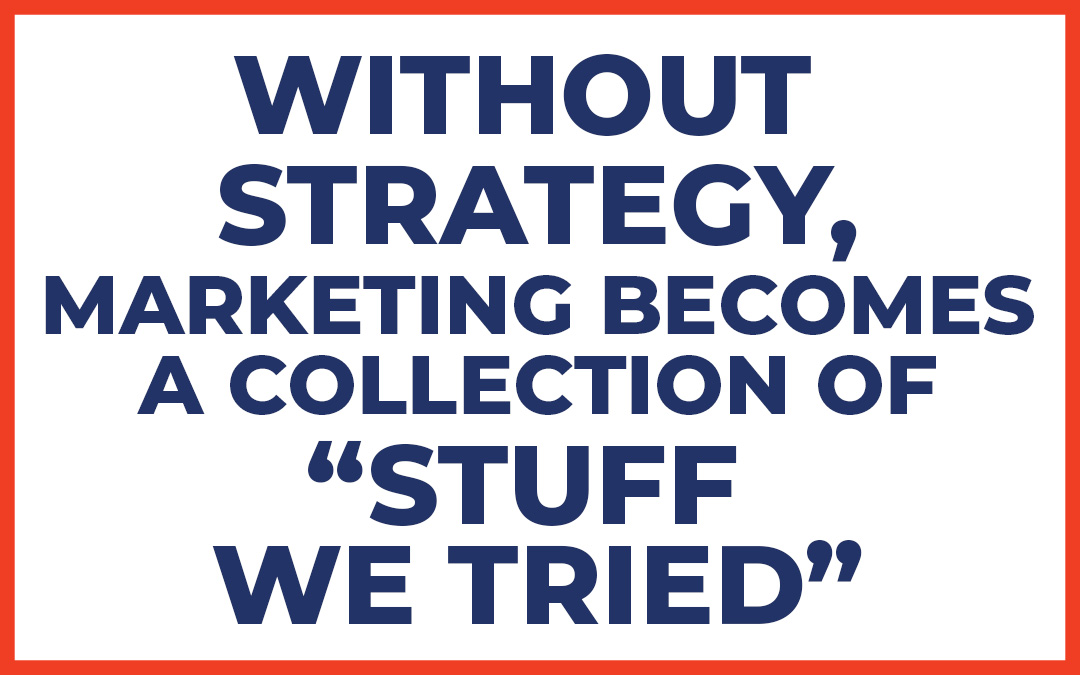A lot of B2B marketing conversations start with tactics.
“Should we be doing SEO?”
“Can you run ads for us?”
“Do you guys manage LinkedIn?”
These are fair questions — but they’re the wrong starting point.
That’s because tactics without strategy are like tools without a blueprint. You might hammer a few nails, but you won’t build anything that lasts.
This is especially true in industrial markets, where marketing is often reactive, underfunded, non-existent, or siloed from sales. Companies feel pressure to “do more,” so they hire a freelancer to manage posts or buy some Google Ads. Then they wonder why it doesn’t move the needle.
Here’s why that approach fails — and what to do instead.
1. Tactics Without Positioning Confuse the Market
Let’s say you’re running search ads without a clear value proposition.
You’ll get traffic. Maybe even some leads. But are they the right people? Do they understand what you do? Can they tell you apart from the competitor in the next tab?
Probably not.
Industrial buyers don’t have time to decode vague offers or squint through ambiguous language. If your tactics don’t reinforce a clear, differentiated position, they’re just noise.
What to do instead:
Start with messaging and positioning. Know who you’re for, why you’re different, and how you reduce risk or cost. Then let tactics amplify that clarity.
2. Disconnected Efforts Create Inconsistent Results
A website built by one vendor. Ads run by another. A trade show plan on someone’s desktop. No shared plan, no consistent goals, no performance loop.
This is what we call “island marketing” — and it’s surprisingly common in mid-sized industrial companies.
Each tactic may work a little. But together? They don’t reinforce each other. Which means wasted money, confused buyers, and sales teams left wondering what marketing is actually doing.
What to do instead:
Build a unified marketing engine. That means centralizing your strategy — even if execution is spread across teams or vendors. Every tactic should ladder up to a core goal and reinforce a consistent message.
3. Good Strategy Helps You Figure Out What NOT To Do
Every industrial company gets bombarded with marketing ideas: “Try TikTok!” “Start a podcast!” “You need video!” And sure — some of these may be valid.
But without a strategy in place, it’s hard to tell the difference between a shiny object and a smart investment.
A good strategy doesn’t just tell you what to do. It tells you what not to do.
It protects your budget. It aligns your internal team. It prevents you from chasing every trend and burning out your marketing coordinator (or yourself).
What to do instead:
Start with strategy. Define your audience, your positioning, your funnel priorities, and your budget. Then use that strategy as a filter — not just a plan.
4. Strategy Makes Tactics More Effective — Not Less Creative
Sometimes people worry that “strategy” is code for “red tape.” That it slows things down or stifles creative ideas.
But the opposite is true.
A good strategy creates focus. It gives every team member — from your agency partner to your junior marketer — a north star to guide decisions. It helps you test ideas faster, measure success better, and course-correct with less waste.
Tactics are the sparks. Strategy is the power grid.
What to do instead:
Empower your team with a strategy that gives them direction and creative freedom. Let them innovate inside a container built for results.
Final Thoughts
Industrial companies don’t need more tactics. They need better alignment between what they say, how they show up, and what they actually want to happen.
Without strategy, marketing becomes a collection of “stuff we tried.”
With strategy, it becomes a system that supports sales, attracts better clients, and drives business value.
Start with the blueprint. Then choose the tools.
Contact us today and let us help you get there.

